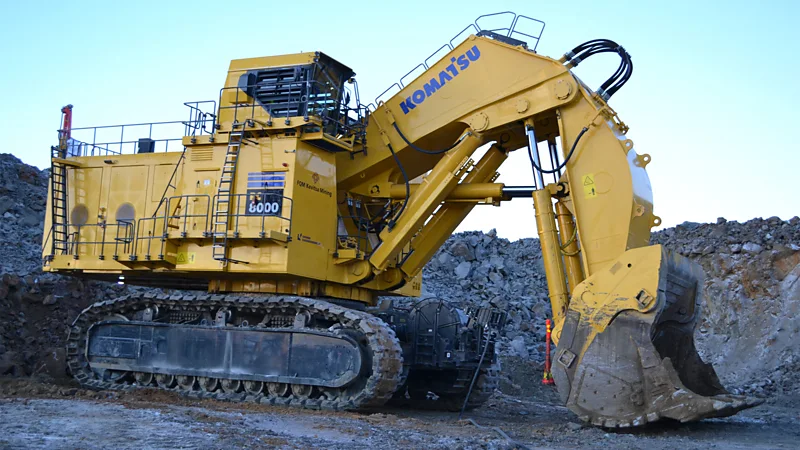Planes, trains and monster diggers: The vehicles pushing the limits of electric power
How much energy you can pack into a battery is one limit on how big an EV can get – but meet the EVs ditching batteries altogether to attain mammoth proportions.

This is no golf cart. This is one of the biggest mining excavators in the world. The clawed bucket it uses for tearing at mineral-laced rock is so big that you could fit more than 3,000 footballs in it. The driver sits in a cab roughly as high up as the roof on an average two-storey British house. And the excavator's hefty caterpillar tracks alone are just shy of 3m (10ft) tall – and about as long as a London bus.
It weighs 778 tonnes in total and you might be forgiven for thinking that this beast, the PC8000-11 surface mining excavator made by Komatsu, could only run on a fossil fuel like diesel. Surely such a behemoth demands all the raw, dirty power of combustion to function? Well, there is a diesel model – but Komatsu have recently brought out an electric equivalent. And it works just the same.
"We are not sacrificing performance when you go electric," says Thomas Jordan, marketing manager at Komatsu Germany. While the diesel excavator guzzles more than 400 litres (88 gallons) of fuel per hour, according to Komatsu, the electric alternative relies instead on a chunky power cable – meaning the vehicle itself produces zero emissions.
When comparing diesel and electric versions of the excavator used by one Swedish customer, well-to-wheel emissions are 95% lower for the electric type, according to Komatsu. This customer has access to electricity from nuclear and hydro sources. Mining companies are increasingly interested in options like this, says Jordan. "We see a trend for more electrification, that's definitely the case."
BBC Future Planet recently went on a hunt for some of the biggest electric vehicles in the world – by size and weight. There is no shortage of impressive examples, from giant mining machines to trains and cargo ships.
Can you dig it?
Bigger electric excavators than the PC8000-11 exist, but Komatsu's vehicle is worth noting for the particularly tough job it does, stresses Jordan. The excavator's hydraulics system allows it to tackle rock – in this class of machinery, the PC8000-11 was the biggest we could find in terms of tonnage. "If you go to the big copper mines and gold mines, you will find hard material where you need that kind of hydraulic excavator," says Jordan.
For a larger electric excavator still, consider one of the biggest vehicles ever built, regardless of fuel type. It holds the Guinness World Record for heaviest land vehicle and it's not even new, having been manufactured way back in the 1990s by the German mining equipment firm Takraf. The colossal Bagger 293 bucket-wheel excavator is used for strip-mining operations in Germany and it weighs a barely believable 14,200 tonnes. That's about the same as 78 empty Boeing 747-400s.
Although the Bagger 293 dwarfs the PC8000-11 in raw tonnage, its job is a little less intense – moving earth and soil instead of rock. Nevertheless, the Bagger 293 requires so much energy that, just like the PC8000-11, it is connected to an electric power source by a cable, rather than using an on-board battery.
Something as large as the PC8000-11 can't run on a battery yet because, with today's technology, the battery pack would weigh more than half as much as the vehicle itself
Ironically, the adoption of electric vehicles in mining has been going on for decades partly because coal mines tend to have their own small power plants, says Jordan. It means they can power electric vehicles on-site at a low cost – albeit using a very polluting power source.
Today, many different kinds of mines are turning to electric vehicles as a way of reducing carbon emissions from their operations. Some mines now even claim to run their machinery largely on renewable electricity. However, reducing emissions from operations only gets you so far – when it comes to coal mining, for instance, the climate-warming emissions from burning its products aren't reduced at all by electrifying the equipment used for extraction.
Mining remains a polluting and dangerous activity in many parts of the world. Globally, extractive industries, including mining, cause an estimated €400bn to €5tn ($440bn to $5.5tn/£340bn to £4.3tn) in environmental damage each year by one estimate. That's even before products such as fossil fuels are burned. But mining is also important for the extraction of minerals such as nickel, copper and gold, which can be used in consumer electronics, solar panels and, yes, electric vehicles.
"For large mining countries like Chile and Australia, they are all looking to the potential to electrify their mining industry," says Zhenying Shao, senior researcher at the International Council on Clean Transportation. She and colleagues have interviewed mine workers who recently started using electric trucks and excavators. Their comments tend to be positive – particularly about the reduction in air pollution and noise made by the vehicles, she says. "They're the ones who drive those machines, [so] that really counts."
Komatsu notes that there are limitations to cable-powered vehicles. The PC8000-11's electric cable is 300m (980ft) long. It's a considerable range, but when the excavator needs to go somewhere else, a small electrical sub-station also has to be relocated in order to power it.
On the road
Outside of mining, there are plenty of other examples of mighty electric vehicles. How much they are capable of dragging behind them can matter for certain applications, as well as their own size and weight. Take the Iveco electric van that, although not large itself, managed to tow 153.58 tonnes. The towed load comprised of a lorry carrying a digger, a truck filled with rocks and an airport fire engine all strung together, one behind the other.
But in terms of weight, heavy goods vehicles are among the largest EVs you might yourself sharing the road with. Volvo's FH Electric truck, if you include its double trailer and load, is among contenders for the heaviest battery-powered electric road vehicle. One currently being trialled in Gothenburg, Sweden, features a 74 tonne, 13m-long (43ft) version of this truck and trailer system. "They are running in commercial traffic every day," says Niklas Andersson, director of electric solutions at Volvo Trucks of the tests.
A slightly lighter, 68-tonne version of this setup is also running in Finland on a 160km (99 mile) route. Although the truck's battery can usually power the vehicle across that entire distance without requiring a recharge, weather conditions can affect performance, says Andersson. "When it's cold you have like 10cm [4in] of slush on the road, which means that the rolling resistance is really bad. Then we have to charge during the way."
He notes that the batteries for these trucks have become rapidly more energy-dense over time. The first version of the battery launched by Volvo Trucks in 2019 weighed about 500kg (1,100lb) and offered 49 kWh of energy. Last year, the company came up with a new battery that is roughly the same size and weight but offers nearly twice as much power – 94 kWh, says Andersson.
The rate of improvement of electric vehicle batteries in recent years has surprised Chris Thorne, director of strategy and operations at UMAS, a maritime consultancy, and advises on various power sources for marine industries.
"In 2015, I'm pretty sure at some point I said heavy goods vehicles will never be battery electric and five years later I was working on it. It taught me a hard lesson," he jokes. Electric drivetrains are actually well-suited to heavy duty machines because they don't require the system of shafts and gears used in petrol and diesel vehicles – these can require higher maintenance over time.
"You have a lot of flexibility in how you lay the vehicle out. You can have a motor on each wheel if you want to," adds Thorne. And he points out that batteries are helpfully modular. You can just keep adding modules until you get the amount of power you need.
There are practical limits, of course. Something as large as the PC8000-11, for example, can't run on a battery yet because, with today's technology, the battery pack would weigh more than half as much as the vehicle itself, according to Komatsu.
Is the sky the limit?
Energy density, the amount of power you can pack into a given volume, is still a barrier for electrifying some vehicles – notably, large aircraft. Though research suggests we might one day see electric passenger aircraft capable of carrying as many as 90 people. The biggest electric planes today can accommodate a maximum of around nine passengers.
The energy density problem also limits electrification of ships, though some surprisingly hefty vessels are beginning to run on battery power. In Incat Tasmania, an Australian shipyard, a ferry currently known as Incat Hull 096, is under construction. When complete, it is planned to have capacity for 2,100 passengers and 225 vehicles – and will be 130m (427ft) long. It was ordered by a Uruguay-based ferry operator.
Finally, the most powerful electric train in the world is perhaps the Shen24 in China. It is capable of carrying more than 10,000 tonnes – of coal – at up to 120km/h (75 mph).
Thorne notes that it isn't really surprising that electric vehicles are becoming so common in heavy industry. These machines have long service lives, tough jobs and cost a lot to buy upfront. So if you can make them cheap to run, say on locally-sourced renewable electricity, and easier to maintain with fewer moving parts than the fossil-fuel-powered alternatives, then they soon become attractive.
On the other hand, not every company or industry is ready to embrace these vehicles just yet. There may be questions over the safety of giant batteries in certain contexts where vehicles might be involved in collisions, for example. Shao says that, while heavy-duty battery electric vehicles are clearly highly capable, some companies may still hesitate about switching to them.
"It's a new technology," she says. "The industry has been dominated by diesel for so long."
-BBC






